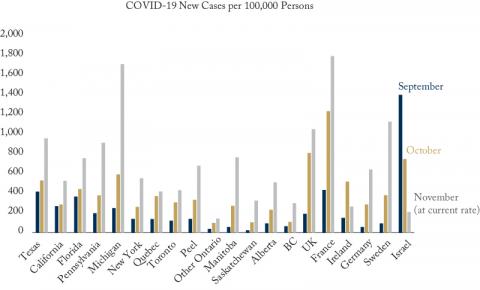To: Ontario Premier Doug Ford and Health Minister Christine Elliott
From: Daniel Schwanen
Date: November 18, 2020
Subject: Containing COVID-19 in Ontario – Skate to Where the Virus is Going
Ontario’s lower case thresholds for triggering stages of progressively tighter socio-economic restrictions, announced Friday, recalibrate its framework to at least bring it more in line with the reality of COVID-19’s rapid spread. That is a good thing.
Introducing the framework was an important step in the right direction. It makes clear what data thresholds guide each level of restrictions, thus providing a degree of rationale to all affected businesses, workers and households. It also provides a hopeful guide for prudent relaxing of restrictions for when case numbers start to drop.
With these changes, each stage of restriction under the framework is more likely to serve as the intended circuit breaker as cases rise, rather than as a mere milestone on the way to a full-blown lockdown. But will they be enough?
Anything short of a policy effectively containing and eventually reducing the incidence of the disease will indeed likely lead to either a severe lockdown or health crisis, and breed cynicism among the public and health practitioners whose support and cooperation is vital to overall success. Perhaps even worse, an ineffective framework risks discouraging too many Ontarians from adopting the rules of behavior that would lower the prevalence of the disease – as is clear from mistrustful public comments left on social media advertisements urging Ontarians to follow the simple directives which have been shown to prevent the spread of the disease.
As we have seen from other jurisdictions, all the guidelines, directives and rules in the world will not work if too many people just do not follow them, if there is confusion in public messaging, or indeed if vital companion elements of Ontario’s framework – such as testing and tracing – do not function as intended. Ensuring the credibility of Ontario’s COVID response framework is vital to enlisting such public support.
In that vein, the framework must also be dynamic. Currently it is set in terms of levels, but clearly by the time the incidence of the virus has reached the next level, it is too often ahead of the policy. This should not be allowed to happen. The experience of other jurisdictions tell us that a sustained rise in cases (or in indicators such as rate of test positivity), beyond a certain low level, should be enough evidence to trigger a meaningful response. This is because the virus does not stop spreading by itself, at least not before potentially wreaking havoc on the most vulnerable and on the very systems that protect and sustain us, including major parts of our economy. The sooner it can be contained, the less the cost of restrictive measures required over time.
In short, the framework must incorporate some way for policymakers to act sufficiently quickly in light of where the virus is skating, not to where it is at the moment, to usefully deploy Wayne Gretzky’s much used metaphor.
The province should consider formally making the restrictions required under the framework a floor only, in any area where active cases are rising sustainably and quickly, formally backing additional emergency measures taken by local authorities regarding places of business or social settings where the virus is shown to be more likely to spread. It should consider reinstating for itself emergency powers last used in the spring, for that purpose. It should also, at this juncture, prepare the ground for introducing emergency specified-duration lockdowns of the “circuit breaker” variety – including travel bans between areas of high and low prevalence – to more reliably move regions where the disease is growing out of control, back to the other side of the wave.
At the same time, Ontario can usefully benchmark its response to the international experience. Despite a record number of new cases set almost daily in the past week and deaths from COVID-19 inevitably rising, most of the province – outside of some large urban hot spots including Toronto and Peel region – still appears like a relative island of containment compared to most European countries other Canadian provinces west of Atlantic Canada, and many US states (see chart). But that is what leaders and the public in many of these jurisdictions – like Israel, France or Manitoba – were telling themselves not that long ago before they had to impose a full lockdown. The struggles of jurisdictions such as Quebec, whose restrictions were harsher and introduced earlier than Ontario’s, or of BC, Alberta, Sweden or Germany, with their relatively lighter touch until very recently, or of US states that are just now reacting with new measures, gives a sense of what can and cannot be achieved to limit the virus’s growth within a range of possible actions and circumstances.
The good news is that in most of Ontario we should be able to bring the number of cases sustainably downward again in relatively short order. There is hope in the experience of Ireland, which enlisted public support for circuit breaker measures with a clearly delineated goal of enabling families to get together for the holidays. Ontarians may need such a unifying vision of what’s possible to get them through the coming weeks.
Daniel Schwanen is Vice-President Research at the C.D. Howe Institute
To send a comment or leave feedback, email us at blog@cdhowe.org.
The views expressed here are those of the author. The C.D. Howe Institute does not take corporate positions on policy matters.






